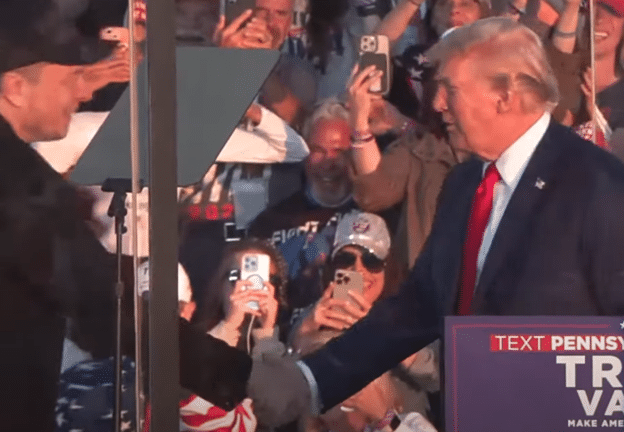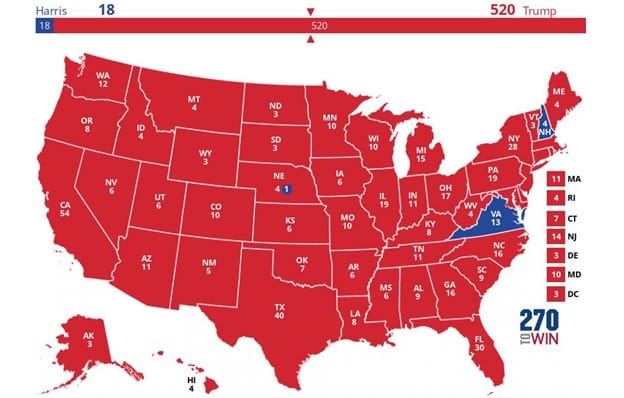
November 8, 2024
Permission to republish original opeds and cartoons granted.
Huge Shifts in Pivotal Pennsylvania Sealed Trump’s Path to Victory with Diverse Coalition
| 
|
|
President Donald Trump’s historic win on Tuesday was largely sealed when he walked away with battleground state Pennsylvania’s 19 electoral votes. The path behind that victory points to a diverse coalition that tipped Pennsylvania back into the Republican camp. Trump made substantial gains compared to 2020 with minority voters and young people, groups conservatives have been relentless in urging Republicans not to overlook. The Trump campaign’s inclusive, America First message resonated big with these voters, who may very well become new conservative voters for decades to come. Trump also made modest gains in urban areas compared to last election, meaning that Kamala Harris appealed less to urbanites than Biden did. Trump gained a stunning nine percentage points with Pennsylvania’s youngest voters according to CNN exit polls, with 44 percent of voters under 30 supporting him this cycle, up from 35 percent four years ago. He also gained seven points with slightly older voters – going from 39 percent of the vote among 30–44-year-olds in 2020 to 46 percent this cycle. According to the data, Trump’s largest gain in Pennsylvania was among voters under age 30 who came out aggressively for him compared to four years ago. Trump actually lost ground slightly with older voters, going from 58 percent of the vote among 45–64-year-olds in 2020 to 54 percent on Tuesday, and going from 53 percent among seniors in 2020 to 52 percent on Tuesday. Young voters are just the tip of the iceberg when it comes to Trump’s inclusive victory, as Hispanic and Black voters switching to the GOP ticket played a pivotal role as well. While the Latino share of the electorate in Pennsylvania is estimated at only about six percent of the total vote cast on Tuesday, Latinos shifted a startling 15 percentage points toward Trump. In 2020 Trump won just 27 percent of the Latino vote in Pennsylvania, but he earned 42 percent of their vote on Tuesday. |
Trent England: Trump wins 520 electoral votes?
| 
|
|
“Over the last fifteen years, seventeen states and the District of Columbia have joined the National Popular Vote interstate compact. NPV is an attempt to nullify the Electoral College in favor of a direct election of the president, but it only takes effect if joined by states that control 270 electoral votes. Right now that total is 209. Yet there is no reason for those states to wait. If they really believe that the national popular vote is the only legitimate way to choose the president and vice president, why not act now—before the election is certified and the electors meet—to put their money where their mouth is? Every NPV state went for Harris. If those states actually followed through on their supposed dedication to the national popular vote concept, they would give their 209 electoral votes to the Republican ticket. That would bring the Trump-Vance total to 520 electoral votes. Harris would receive just 18 electoral votes: 13 from Virginia, 4 from New Hampshire, and 1 from Nebraska’s second congressional district.” |
Huge Shifts in Pivotal Pennsylvania Sealed Trump’s Path to Victory with Diverse Coalition

By Manzanita Miller
President Donald Trump’s historic win on Tuesday was largely sealed when he walked away with battleground state Pennsylvania’s 19 electoral votes. The path behind that victory points to a diverse coalition that tipped Pennsylvania back into the Republican camp.
Trump made substantial gains compared to 2020 with minority voters and young people, groups conservatives have been relentless in urging Republicans not to overlook. The Trump campaign’s inclusive, America First message resonated big with these voters, who may very well become new conservative voters for decades to come. Trump also made modest gains in urban areas compared to last election, meaning that Kamala Harris appealed less to urbanites than Biden did.
Trump gained a stunning nine percentage points with Pennsylvania’s youngest voters according to CNN exit polls, with 44 percent of voters under 30 supporting him this cycle, up from 35 percent four years ago. He also gained seven points with slightly older voters – going from 39 percent of the vote among 30–44-year-olds in 2020 to 46 percent this cycle.
According to the data, Trump’s largest gain in Pennsylvania was among voters under age 30 who came out aggressively for him compared to four years ago. Trump actually lost ground slightly with older voters, going from 58 percent of the vote among 45–64-year-olds in 2020 to 54 percent on Tuesday, and going from 53 percent among seniors in 2020 to 52 percent on Tuesday.
Young voters are just the tip of the iceberg when it comes to Trump’s inclusive victory, as Hispanic and Black voters switching to the GOP ticket played a pivotal role as well. While the Latino share of the electorate in Pennsylvania is estimated at only about six percent of the total vote cast on Tuesday, Latinos shifted a startling 15 percentage points toward Trump. In 2020 Trump won just 27 percent of the Latino vote in Pennsylvania, but he earned 42 percent of their vote on Tuesday.
In recent years Latino men have been voting Republican in higher proportions than women and this was true nationally this election as well. While data is still being tabulated from Arizona and Nevada, Trump appears to have gained at least fourteen percentage points with Latinos nationwide, going from 32 percent in 2020 to 46 percent this year, with sizeable gains from men.
As exit polling stands now, Trump has outright won Latino men, making a massive nineteen-point gain among Latino men compared to four years ago. Trump won 36 percent of Latino men in 2020 but has earned 55 percent of their vote thus far. For context, this is very close to the share of white men Trump earned this cycle – 60 percent. Among Latino women, Trump also gained, but by less. He is sitting at a sizeable eight-point gain with Latino women compared to 2020, going from 30 percent to 38 percent, just seven points shy of Trump’s share of white women this cycle.
Black voters made up approximately nine percent of the electorate in Pennsylvania according to exit polls, and while their shift toward the right was smaller than that of Latinos, it was still notable. Trump gained three points with Black voters, going from 7 percent of their vote to ten percent. A vast majority of those gains among Black voters occurred among men, with Trump gaining sixteen percentage points with Black men compared to 2020. Trump earned a full twenty-six percent of the Black male vote in Pennsylvania this year, compared to ten percent last election. He lost a single percentage point to Harris with Black women this year.
Trump also made urban gains compared to 2020, an unlikely group that tends to skew heavily Democrat. However, urban Pennsylvanians were more likely to give Trump a chance to fix pressing issues like crime and the economy this year, and supported Trump by six percentage points more compared to 2020. This shift among the urban vote proves that the America First message is far-reaching, and something Americans from cities and small towns alike can get behind.
Pennsylvania has long been a pivotal target because of its vast number of electoral votes, and Trump won Pennsylvania in 2016 but apparently ceded it in 2020. This time, he tipped Pennsylvania in favor of the America First agenda with the help of a diverse coalition of voters. Americans for Limited Government Foundation will continue to analyze the rightward shift of Latinos, young people, and urbanites, because this trend was far from concentrated to Pennsylvania.
Manzanita Miller is the senior political analyst at Americans for Limited Government Foundation.
To view online: https://dailytorch.com/2024/11/huge-shifts-in-pivotal-pennsylvania-sealed-trumps-path-to-victory-with-diverse-coalition/


Trent England: Trump wins 520 electoral votes?
By Trent England
Over the last fifteen years, seventeen states and the District of Columbia have joined the National Popular Vote interstate compact. NPV is an attempt to nullify the Electoral College in favor of a direct election of the president, but it only takes effect if joined by states that control 270 electoral votes. Right now that total is 209.
Yet there is no reason for those states to wait. If they really believe that the national popular vote is the only legitimate way to choose the president and vice president, why not act now—before the election is certified and the electors meet—to put their money where their mouth is?
Every NPV state went for Harris. If those states actually followed through on their supposed dedication to the national popular vote concept, they would give their 209 electoral votes to the Republican ticket. That would bring the Trump-Vance total to 520 electoral votes. Harris would receive just 18 electoral votes: 13 from Virginia, 4 from New Hampshire, and 1 from Nebraska’s second congressional district.

Of course, NPV states can’t actually do this. While they’ve passed the compact, it’s not in effect. Their current laws select electors based on the in-state vote. That means their electors will be Democrats. Then again, those Democrat-nominated electors could endorse the concept of a national popular vote by casting ballots for Trump and Vance (at least in states without “faithless elector” laws).
There is really no reason for the NPV compact to have a trigger in the first place. Consider that without the trigger, all an NPV state could do is either stay the same, join the winning side (if the electoral and popular votes are the same, like this year), or flip the outcome to the popular vote winner (if the electoral and popular vote results were different). The only reasons to have a trigger are to avoid public scrutiny of the compact, including of its many technical defects and lacunae.
To view online: https://saveourstates.com/blog/trump-wins-520-electoral-votes
